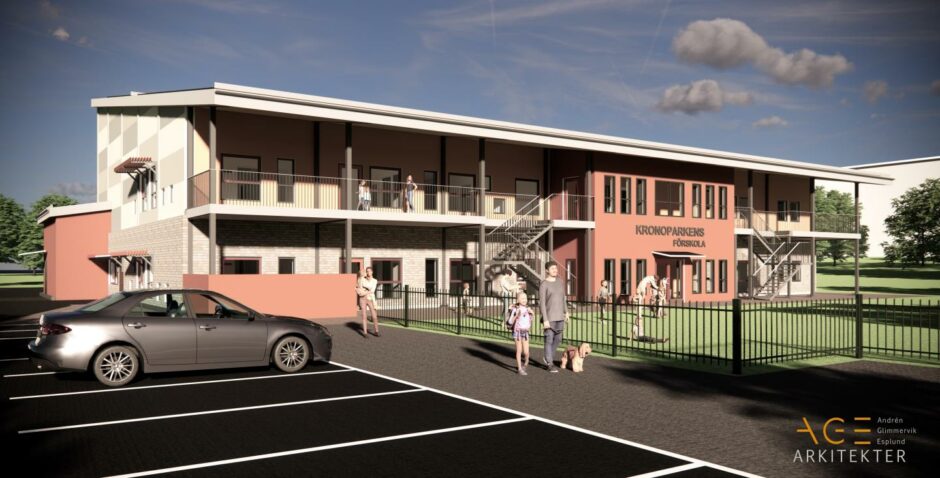
There are those that only talk about Net Zero – the “talkers”, those that are forever preparing Net Zero plans and studies – the “ditherers”, and those who are really getting on with implementing genuine Net Zero – the “doers”.
Mariestad is a very pretty town that sits on the eastern shore of Lake Vänern in southern Sweden. It has a relatively small population of 25,000 but its size hasn’t proven to be an obstacle when it comes to developing solutions for tackling climate change. They’re an example of the “doers”.
On the 18th of January this year it inaugurated a completely off grid powered “preschool”, or kindergarten as we know them, which will cater for 140 children. That’s larger than some rural primary schools in Scotland.
Needless to say the building itself has been constructed to meet very high thermal loss standards but the solar cells on the roof provide enough energy for the kindergarten’s daily needs and the surplus is used to drive a Danish built electrolyser which takes water from Lake Vänern to produce hydrogen. That hydrogen – 1140 Kg at 300 bar – is stored just off site and used during the darker winter months to provide both heat and power using a fuel cell-based combined heat and power plant.
Reading between the lines one of the biggest challenges was the regulatory hurdle that had to be jumped to enable the storage of green hydrogen – amounting to around 40 MWh – in a built-up area. I can imagine that dealing with something so new the risk analysis would have involved a great deal of head scratching but it’s now set the standard for future projects globally.
The whole system was designed and installed by Nilsson Energy who have pioneered off grid hydrogen-based energy systems in Sweden.
Oh, and by the way, Mariestad was the first town in Sweden to install a hydrogen fuelling station. It now has a fleet of ten hydrogen cars owned by the council.
Of course, as well as solar cells you could also use a wind turbine and hydro or tidal power to drive the electrolyser or indeed any combination of those. It’s also an entirely scalable solution so could equally be applied to larger buildings and even entire communities.
Importantly, such a solution also provides 100% resilience. No more shutting schools or endangering communities due to power cuts caused by the increasing number of storms we’re experiencing.
Further South a project at the MPREIS GmbH family-owned supermarket chain food production centre in Völs, Austria, to develop a bakery using a hydrogen fired oven is almost complete. I’m an avid bread baker – don’t laugh – so this really interested me but it’s another example of a forward-thinking company developing a hydrogen-based solution to decarbonise a part of their business that’s contributing to climate change for the simple reason, as the project manager put it, “because we have to”. They’re also “doers”.
Using a combination of hydro and solar-generated electricity, a 3.2MW pressurised alkaline electrolyser manufactured by the German company Sunfire in Switzerland produces hydrogen at 30 Bar that can be stored in three large type 1 tanks manufactured in Austria.
This hydrogen is then used to fire a bakery oven which uses a dual-fuel burner designed, developed and built by the Franco-German company burner specialist Fives Pillard GmbH. It’s a dual fuel burner which can also deal with natural gas just in case for any reason they run out of hydrogen, which they’re not expecting to do but it makes sense to provide a back-up.
Fives Pillard worked closely with Classen Apparatebau Wiesloch GmbH who specialise in high temperature process heat technology and HEUFT Thermo-Oel GmbH the industrial oven manufacturer thus demonstrating how European companies come together to increase their industrial benefit although it helps if they have existing supply chains that are willing and eager to adopt and adapt to support their net zero
MPREIS has 300 stores throughout Austria, so this is not a small-scale exercise. As an aside, 12 of these stores now conform to the “passiv-haus” standard which is more confirmation of the company’s Net Zero credentials.
Bread baking is also not the only application they have for the hydrogen they’re producing. In the next phase of this ambitious project, they’re intending to convert their delivery lorry fleet to hydrogen. In fact, the first three are being delivered by Hyzon shortly and the hydrogen filling station will be completed in the second quarter.
Watching our European friends investing time, effort and a lot of money into developing these projects and the technology that underpins them is encouraging for a number of reasons. Most pertinent of these is that given the current political climate in Europe they are perfect examples of how to reduce and eliminate reliance on Russian gas.
However, both projects were aimed simply at decarbonising two economically and socially critical activities namely, education and bread making. Both are every-day activities for which we now know hydrogen is entirely appropriate and we in this country should be learning from this. There are plenty of similar applications here that we need to decarbonise. Every kindergarten, school, college and university for a start.
Dick Winchester is a former subsea engineer and an adviser to the Scottish government on the energy transition.